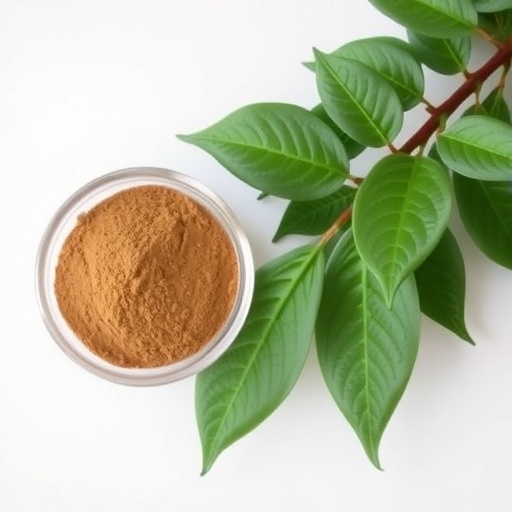In the exhilarating realm of medicinal plant research, few studies capture the imagination quite like the one recently published by Espinoza-Rivera, Chávez-Flores, Serván-Meléndez, and their colleagues. This investigation delves into the acute toxicity evaluation of the ethanol extract from the leaves of Minquartia guianensis Aubl, commonly known as Huacapú. The research exemplifies the rigorous scientific methodology often employed to unravel the complexities of plant-based therapeutics, providing insights into both the potential benefits and risks of using such natural extracts in medicinal applications.
Within the heart of the Amazon rainforest, the Huacapú tree stands tall and proud, revered not only for its majestic presence but also for its storied history in traditional medicine. Indigenous communities have long recognized the therapeutic properties of its leaves, utilizing them to treat various ailments. However, while anecdotal evidence suggests great efficacy, scientific substantiation remains crucial for broader acceptance in the medical community. This study marks a pivotal step in confirming the safety and biological effects of Huacapú’s ethanol extract through a meticulous acute toxicity evaluation.
The primary objective of this research was to assess the hematological and histopathological effects of the ethanol extract on an animal model. By carefully selecting a well-established model, the researchers ensured that the findings would contribute meaningfully to the broader scientific literature. This focus on using an animal model is essential, as it enables scientists to closely monitor physiological responses and gain insights that would be difficult to ascertain through in vitro studies alone.
Before embarking on their experiment, the researchers conducted an extensive literature review, evaluating existing studies on Minquartia guianensis. This comprehensive approach not only highlights the gaps in current knowledge but also underscores the significance of their contributions to the field. By synthesizing previous findings, they established a solid foundation upon which they could base their hypotheses and experimental design.
In their methodology, the researchers utilized a systematic approach to determine the appropriate dosage of the ethanol extract to administer to the animal subjects. This careful calibration is pivotal in toxicity studies, as it helps delineate safe exposure levels from those that could elicit adverse reactions. After establishing baseline health metrics for the animals, the team meticulously monitored their responses post-administration.
Throughout the study, various hematological parameters were assessed, including red and white blood cell counts, hemoglobin concentration, and platelet levels. These metrics are crucial in evaluating the impact of the ethanol extract on the circulatory system, as variations could indicate toxicological effects. The researchers utilized advanced analytical techniques to ensure accuracy and reliability in their assessments, further solidifying the robustness of their findings.
In addition to hematological analysis, histopathological examinations were conducted on tissue samples post-experimentation. This involved detailed inspection of key organs, allowing the researchers to identify any morphological changes that may have occurred as a consequence of the ethanol extract. Such analyses are vital in comprehensively understanding the biological effects of the extract and informing future research directions.
The findings of the study were indeed promising. The ethanol extract from Minquartia guianensis exhibited minimal acute toxicity, suggesting its potential as a safe therapeutic agent when used judiciously. Notably, the researchers observed only minor alterations in hematological parameters, with no significant dysregulation noted. These results provide a compelling argument for further exploration of Huacapú’s healing potential, especially given its rich traditional history.
Despite the encouraging findings, the researchers were careful to emphasize the necessity of ongoing evaluation. While their study lays a solid foundation, it also highlights the multifaceted nature of herbal medicine research, which demands further exploration to consider chronic toxicity and long-term effects. The delicate balance between efficacy and safety remains a guiding principle, urging continued investigation into the pharmacological properties of plant-based extracts.
Moreover, the implications of this research extend beyond academics; they pave the way for potential therapeutic applications. Should future studies corroborate these findings, there exists a world of possibility for the formulation of herbal medicines derived from Huacapú. The integration of such traditional medicines into mainstream healthcare could represent a significant shift in how we approach treatment and wellness.
As researchers continue to unravel the intricate tapestry of plant-based medicine, studies like this hold immense value in bridging the gap between tradition and modern science. The careful evaluation of Minquartia guianensis enriches our understanding and opens doors to promising new therapies waiting to be discovered. The fascination surrounding plant extracts and their therapeutic potential amplifies with each significant contribution to the body of knowledge.
Ultimately, the study serves as both a reminder and a clarion call for continued research in the field of ethnopharmacology. As the scientific community grows increasingly aware of the importance of traditional medicines, the spotlight shines brighter on the need for rigorous testing and validation. With diverse natural resources at our disposal, the quest for safe and effective treatments must encompass both innovation and respect for centuries-old wisdom held within the annals of herbal medicine.
In conclusion, the work of Espinoza-Rivera et al. has opened a vital dialogue about the potential harnessed within Minquartia guianensis. By skillfully navigating the realms of toxicity evaluation, hematological assessment, and histopathological analysis, they invigorate the conversation about the interplay between traditional healing and modern scientific inquiry. As we look ahead, let us celebrate this study and acknowledge its role in forging a path where nature’s bounty could lead the charge in future medicinal advancements.
Subject of Research: Acute toxicity evaluation of the ethanol extract from Minquartia guianensis Aubl leaves.
Article Title: Acute toxicity evaluation of the ethanol extract from Minquartia Guianensis Aubl (Huacapú) leaves: hematological and histopathological analysis in an animal model.
Article References:
Espinoza-Rivera, J., Chávez-Flores, J., Serván-Meléndez, J. et al. Acute toxicity evaluation of the ethanol extract from Minquartia Guianensis Aubl (Huacapú) leaves: hematological and histopathological analysis in an animal model.
BMC Complement Med Ther 25, 397 (2025). https://doi.org/10.1186/s12906-025-05092-6
Image Credits: AI Generated
DOI: 10.1186/s12906-025-05092-6
Keywords: Huacapú, Minquartia guianensis, acute toxicity, ethanol extract, hematological analysis, histopathological analysis, medicinal plants.
Tags: acute toxicity evaluationAmazon rainforest plantsethanol extract safety studyhematological effects of plant extractshistopathological analysis in toxicologyHuacapú medicinal propertiesindigenous medicine and sciencemedicinal plant toxicity assessmentMinquartia guianensis leaf extractnatural remedies risksscientific methodology in herbal researchtraditional medicine research





